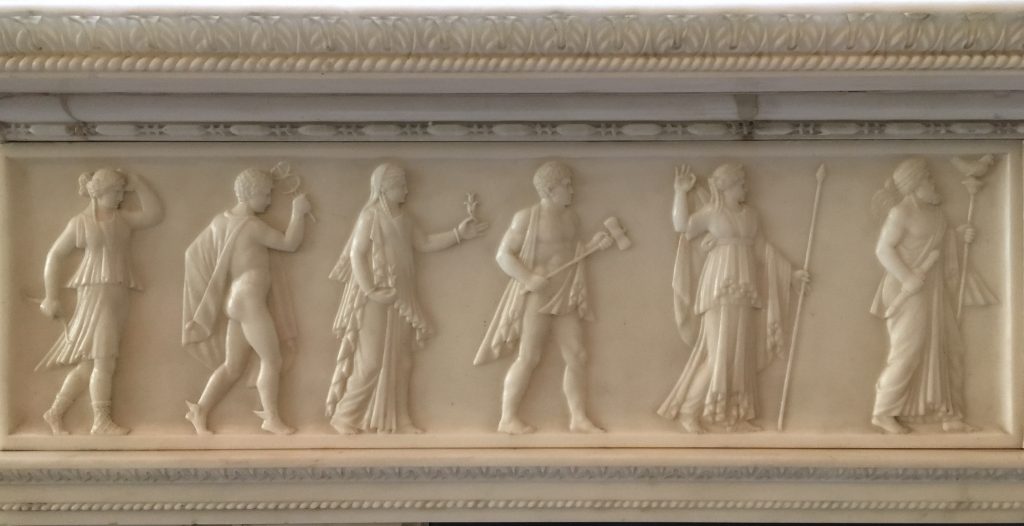The annual mark of Spring for us is when the wisteria blossoms in our garden in Camberwell. It truly is a beautiful sight.
Easter and New Beginnings.
14 April 2017

As Easter is upon us, we are taking the children to Seville which we are hugely excited about. We leave the shop behind for a week, which is full of pieces that mark new beginnings. In the mythology of Ancient Rome, the god Janus represented new beginnings. He is associated with gates and doors and taking the first step.

A well carved 19th century Roman marble figure of the Roman God Janus sits upon a neoclassical antique chimneypiece.
Just as he looks to the future:

There is always the connection to the past:

He symbolises the beginning and end of conflict. During times of war, the doors of his temple were left open, with the arrival of peace, the doors were closed. Interestingly, the Greeks had no equivalent to this Roman God. However the twelve Roman Gods portrayed in this magnificent antique chimneypiece recently stood in our showroom, all have Greek representatives.

A neoclassical antique chimneypiece recently stood in our London showroom.
This late 18th century, early 19th century, (circa 1800) mantel is English, carved in Italian statuary marble. The twelve gods walk towards the empty throne of the sun god Apollo.

Angels protect the empty throne of the Sun God Apollo.
On the left of the frieze is Apollo’s twin, the Greek goddess, Artemis (the Roman goddess equivalent is Diana),the virgin huntress holding a bow and reaching for an arrow: the athletic personification of chastity and fertility. Next is Hermes (Mercury), Apollo’s half-brother, the messenger of the gods, wearing winged sandals and holding his Caduceus. Beside him is Demeter (Ceres) goddess of agriculture holding ears of corn.

Next follows Hephaestus (Vulcan) god of fire and blacksmith, holding his hammer. Aphrodite (Venus) the goddess of love, beauty and fertility is beside him. Then walks Zeus (Jupiter) god of the sky, supreme ruler and chief of the twelve Olympians, holding his eagle aloft with a thunder bolt by his side.

On the right side of the central tablet is Heracles (Hercules) another half-brother of Apollo, the god of strength and Heroic endeavour. He in turn is followed by Apollo and Artemis’ mother Leto (Latona) who holds an oriental lotus palm. Erato follows next, one of the companions of Apollo, the muse of lyric and love poetry. The next depiction is Athena (Minerva), the goddess of war, wisdom and the arts. Then walks Ares (Mars) another God of war, followed by Poseidon (Neptune) the God who ruled the seas, carrying his three pronged trident.
I always get so excited when I get to own these great, extremely rare, works of art and this is certainly one mantel I will not easily forget.

The exquisite hand crafted depictions of the Greek goddesses and gods. Detail shown here of Artemis, Hermes and Demeter.
Another significant antique in the showroom at the moment that is particularly relevant to this season of Spring, of nature, birth and growth, is an extremely fine George II carved and painted pier mirror, in the manner of William Kent, centred by a baroque cartouche above a mask of the Goddess Diana. In Ancient Rome, Diana was seen as the goddess of fertility and the Moon and of chastity. Sanctuary was found in her temples, and women seeking to conceive healthy children believed in her. The temple in Ephesus was one of the wonders of the world. It was rebuilt three times before its final destruction in 401 AD.

Portrayed with bow and arrow and accompanied either by a deer or hounds, Diana was the goddess of both wild and domestic animals and of woodland. In later centuries, Diana figured in European myths of the female Wild Hunt. During the Renaissance, she became a popular figure in art, poetry, and drama. The rectangular mercury plate with trailing oak leaves and scrolling foliate base can be compared to a highly important mirror that can be found in The Revised Dictionary of English Furniture (Vol II P335, Fig 62), at Ragley Hall Warwickshire.
New beginnings continue for us when we return from Seville as we would have completed our own herculean task of moving our warehouse and workshops to a new space just outside London. We bought our wonderful, 22,000 sq. ft. warehouse, that used to be a tank factory, at the end of last year and we are so excited to start afresh and have two hugelighting and chimneypiece workshops to produce from. Supporting our Pimlico showroom, our highly skilled craftsman will have so much added room to hand finish our lighting and make our chimneypieces.



